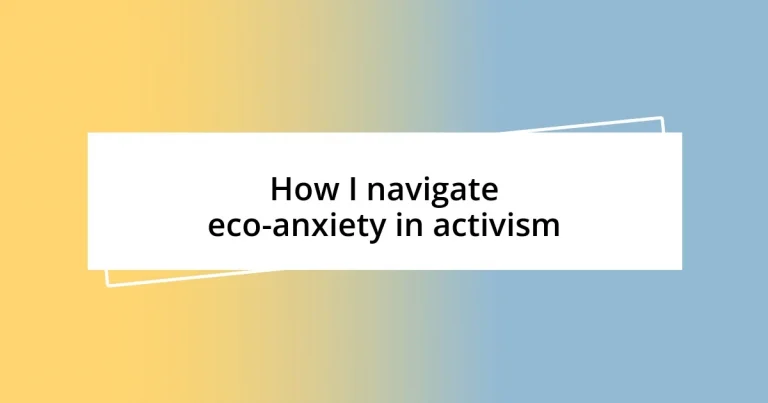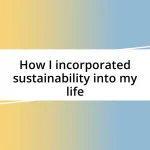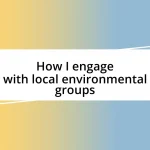Key takeaways:
- Eco-anxiety affects emotional and physical well-being, leading to withdrawal from social interactions and physical symptoms like tension headaches.
- Recognizing personal anxiety triggers, such as specific news stories and negative discussions, is crucial for managing eco-anxiety and maintaining mental health.
- Engaging in positive activism and connecting with supportive communities fosters resilience, celebrates small victories, and promotes a balanced approach to activism and self-care.
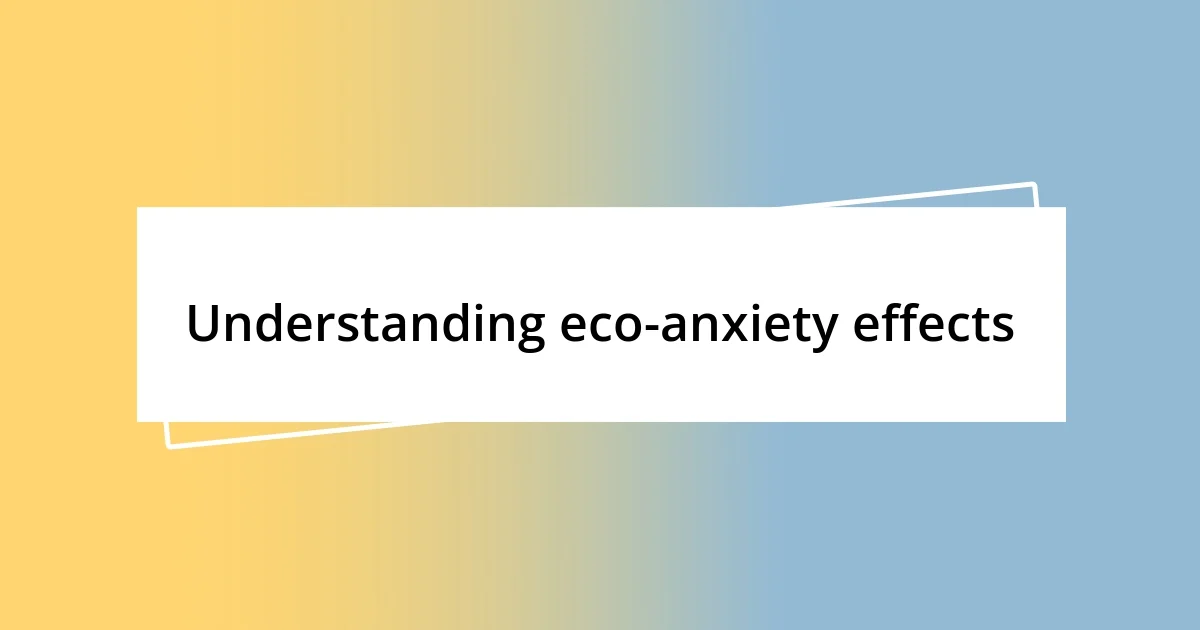
Understanding eco-anxiety effects
Eco-anxiety isn’t just a buzzword; it manifests in real emotional and physical ways. I remember a time when I felt overwhelmed by the climate news, almost suffocating in despair. Have you ever caught yourself losing sleep, your mind racing with thoughts about rising sea levels or melting glaciers? It’s as if we’re constantly balancing on a tightrope between hope and fear.
The effects extend beyond our minds; they seep into our daily lives. I’ve found myself withdrawing from social events because the weight of environmental issues felt too heavy to carry in conversations. It’s a fascinating and alarming pattern—how do our concerns about the planet shape our interactions and sense of community? We should examine how frequently these thoughts interrupt our joy, blurring the lines between awareness and paralysis.
I’ve also noticed physical symptoms creeping in, like tension headaches or a racing heart when I hear discouraging climate statistics. Why does something as abstract as climate change physically affect us? It’s a reminder that our emotional and physical states are intertwined, urging us to be mindful of our well-being as we navigate activism.
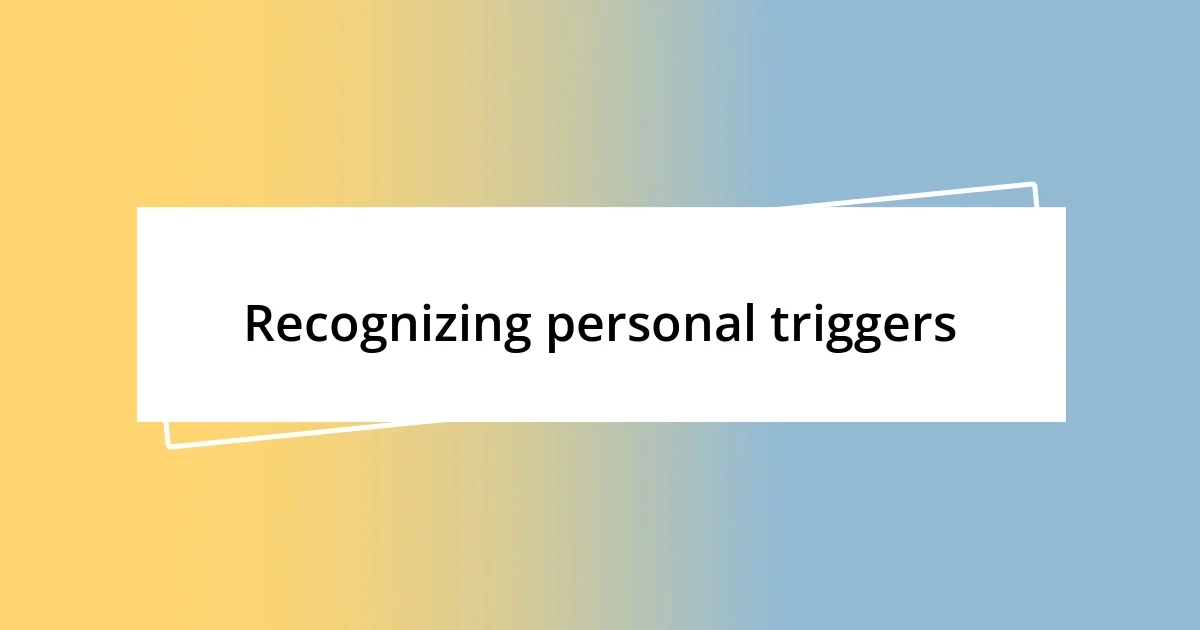
Recognizing personal triggers
Recognizing my personal triggers has been a crucial step in managing eco-anxiety. There are certain news stories or social media posts that can send me spiraling into a state of hopelessness, making it vital to identify these moments. For instance, I remember scrolling through a disturbing article about deforestation and feeling my stomach drop. Acknowledging that my emotional response stems from specific triggers helps me regain control of my reactions.
I also find that certain discussions, especially those laden with negativity, amplify my anxiety. There have been times when engaging in conversations filled with despair around climate issues left me feeling drained and helpless. By noting which discussions trigger my overwhelming emotions, I can set boundaries and preserve my mental health. It’s empowering to recognize that I have the agency to step back when needed.
Moreover, time of day plays a surprising role in my triggers. For example, I tend to feel more vulnerable in the evenings when my mind is less occupied. I recall a particular night feeling especially anxious after watching a documentary about climate change before bed. It served as a powerful reminder that timing matters and influenced how I manage my media consumption.
| Trigger Type | Personal Insight |
|---|---|
| News Stories | I felt overwhelmed reading about deforestation. |
| Conversations | Negative discussions left me drained and anxious. |
| Time of Day | Evenings make me more vulnerable to anxiety. |
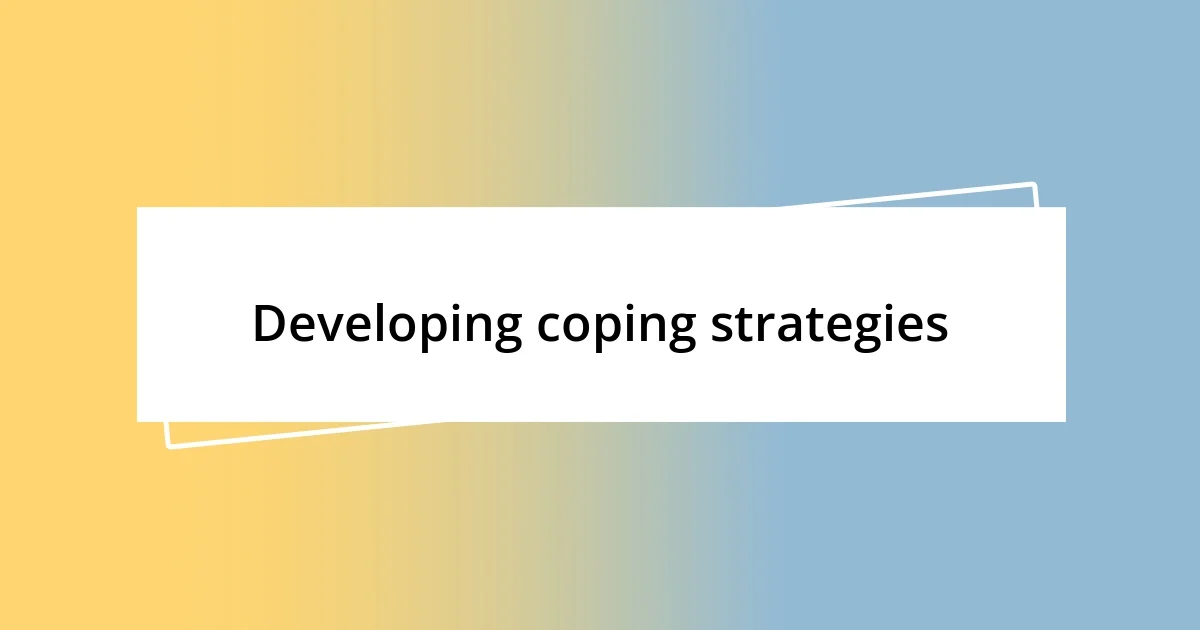
Developing coping strategies
Developing coping strategies is vital in mitigating the impact of eco-anxiety. Through my own journey, I’ve discovered that incorporating mindfulness practices into my daily routine helps create a buffer against overwhelming emotions. For instance, when I feel the anxiety creeping in, I take a moment to breathe deeply and focus on the present, letting go of distressing thoughts. I often find a quiet spot, perhaps in nature, where the soothing sounds and sights can gradually calm my racing thoughts. This simple act of grounding myself makes a world of difference and reminds me that, despite the chaos around us, there’s beauty to appreciate right now.
I’ve also learned to engage with my community in ways that strengthen my resolve rather than diminish it. Here are some strategies I’ve found effective:
- **Limit Media Exposure**: I take breaks from social media and news to avoid feeling bombarded by negative information.
- **Connect with Nature**: Spending time outdoors helps me reconnect with the reasons I care about the environment in the first place.
- **Create a Support Network**: Surrounding myself with positive, like-minded individuals makes discussing activism uplifting rather than exhausting.
- **Practice Gratitude**: I keep a journal to write about things I’m grateful for every day, which helps shift my perspective toward the positive.
- **Engage in Creative Outlets**: Whether it’s art, writing, or gardening, finding a way to express my feelings fosters healing and purpose.
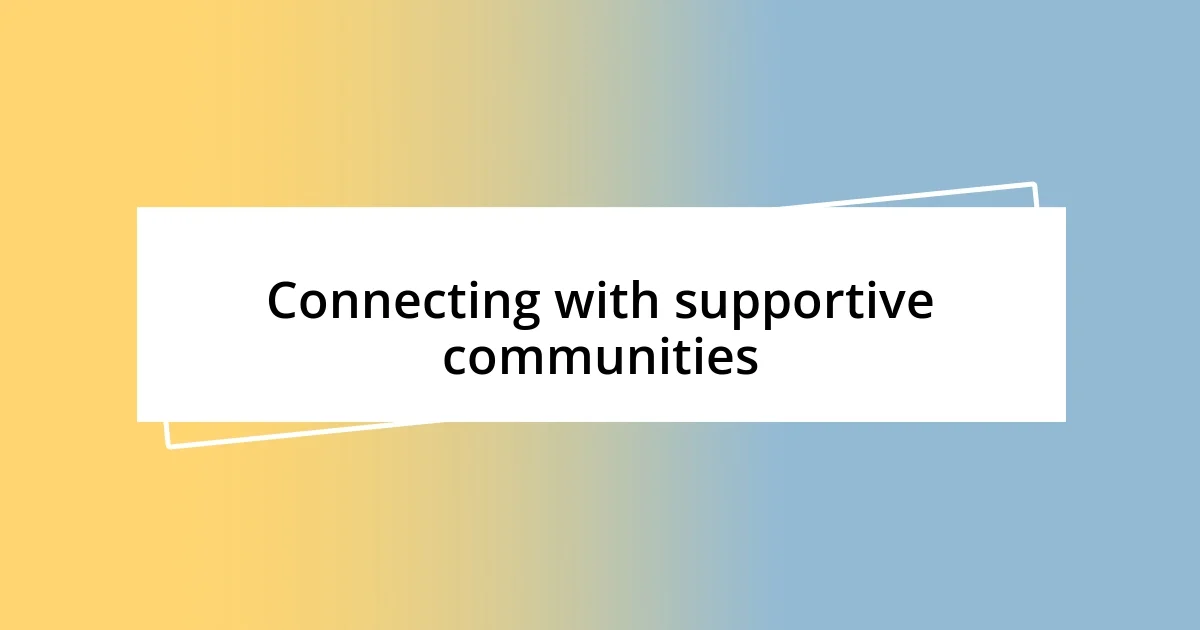
Connecting with supportive communities
Finding supportive communities has been a transformative experience for me. When I first immersed myself in activism, I often felt isolated, but joining local environmental groups opened up a world of connection. It’s remarkable how sharing your concerns and experiences with others who truly get it lightens the emotional load. Have you ever felt that sense of relief when someone voices your thoughts? I vividly remember my first meeting; we all sat in a circle, discussing our eco-anxieties, and I left feeling buoyed by not only their passion but also their understanding.
Engaging with these communities has been more than just sharing fears; it’s become a source of inspiration. For instance, I participated in a collaborative art project aimed at raising awareness about climate change. Collaborating with others not only allowed me to channel my anxiety into something creative but also fostered lasting friendships. I marveled at the power of collective action—when we combine our voices and talents, we can drive meaningful change. Have you ever created something with others that felt bigger than yourselves? Those moments remind me that we are not in this fight alone; together, we amplify our impact.
Additionally, I’ve found that varying levels of involvement can help manage eco-anxiety. There are days when I need to dive into activism headfirst, while on others, I prefer just to attend meetings for support without feeling pressured to contribute heavily. This flexibility allows me to stay engaged without burning out. I often ask myself, “What feels right for me today?” This mindful approach ensures that my activism remains sustainable and in tune with my emotional state. I encourage you to explore how connecting with a supportive community can enrich your journey, as it certainly has enriched mine.
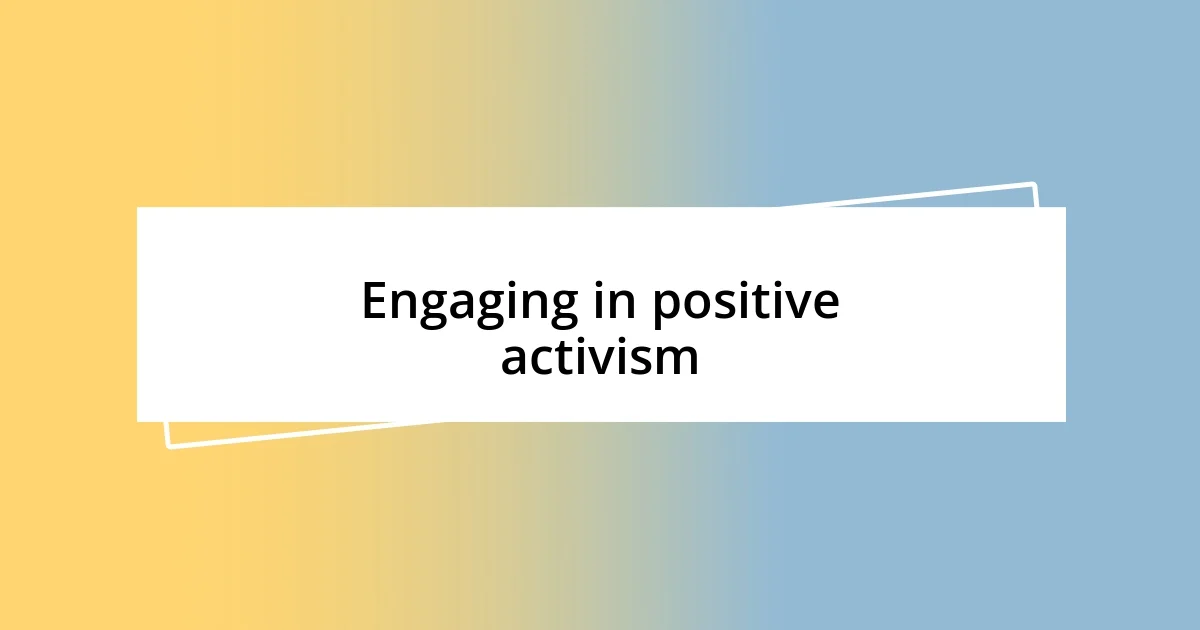
Engaging in positive activism
Engaging in positive activism means focusing on actions that uplift not only oneself but also others. I’ve experienced that participating in community clean-up events is both fulfilling and rewarding. The collective energy is palpable; there’s something special about working side by side with others, armed with trash bags and a shared purpose. It’s a tangible reminder of how filling our surroundings with care can spark joy and motivate change. Have you felt that sense of camaraderie when picking up litter alongside fellow activists? It’s a bonding experience that transcends individual worries.
One approach I cherish is creating positive narratives around activism. Instead of fixating on despair, I focus on sharing success stories. For instance, after organizing a tree-planting event last year, I was blown away by how many people showed up, ready to roll up their sleeves. The laughter and chatter while planting saplings was infectious. I often reflect on how those little trees symbolize hope—each one a step toward restoring our planet. Isn’t it powerful to think that despite the daunting challenges we face, we can still grow something beautiful?
Lastly, I’ve discovered the importance of celebrating small wins. I remember when my team successfully lobbied for a plastic ban in our local market. The excitement was contagious—we even had a small celebration afterward! Acknowledging these victories, no matter how small, fuels our motivation and reinforces the idea that every effort counts. When was the last time you took a moment to recognize your contributions to a cause? Engaging in positive activism allows me to celebrate alongside others, creating a ripple effect of hope in our community.
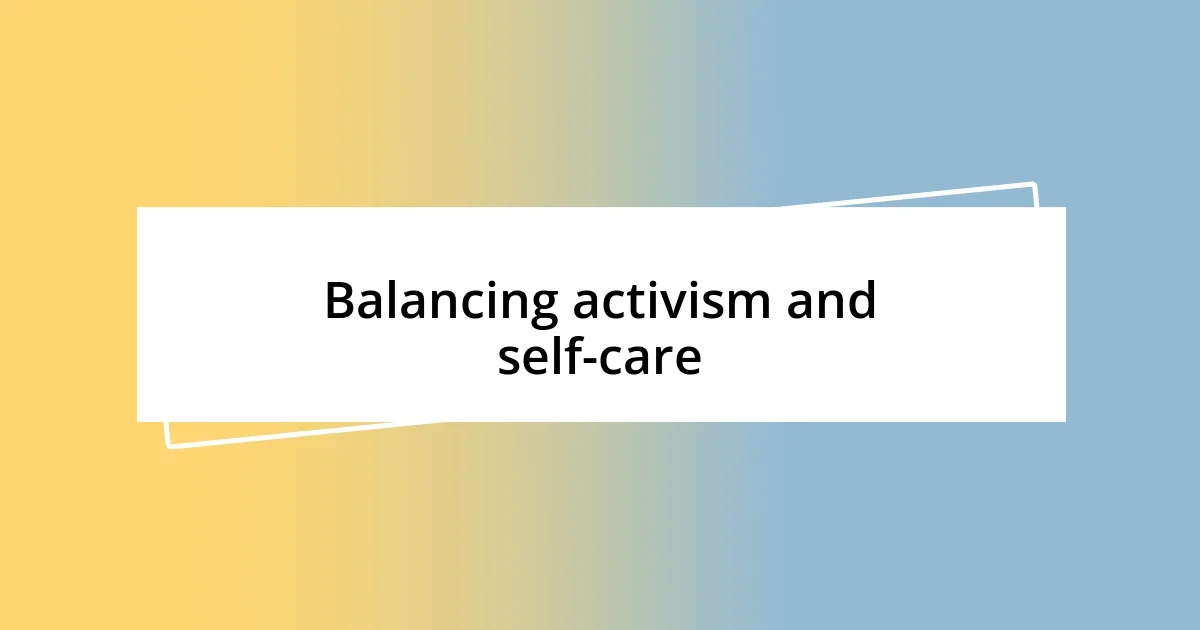
Balancing activism and self-care
Finding the right balance between activism and self-care is essential for maintaining long-term engagement. I remember a time when I was deeply immersed in organizing a large environmental rally. The excitement was palpable, but I realized I was neglecting my own needs. After a few sleepless nights, I had to pause and ask myself, “What am I doing to nurture my own well-being?” That moment of reflection was crucial; I learned that taking breaks to recharge emotionally and physically doesn’t mean I’m less dedicated—it makes me more effective.
I’ve also found that setting clear boundaries can be a game changer. When I first got involved, it felt like I had to be available 24/7 to make an impact. However, I quickly discovered the power of saying “no” sometimes. For instance, dedicating one evening a week to a hobby, like painting or going for a walk in nature, lets me return to activism refreshed and more inspired. Have you ever noticed how stepping away, even for a short while, can give you a new perspective? It’s in those quieter moments I often generate some of my best ideas for engagement.
Lastly, I value the practice of mindfulness within my activism routine. I once took an online workshop focused on mindfulness and activism, and it was transformative. Learning to incorporate deep breathing and intentional pauses before meetings helped me approach discussions with a clearer mind and a calmer spirit. I now often remind myself, “Am I coming from a space of fear or love?” This shift in perspective has allowed me to engage with others positively while protecting my emotional health. How do you integrate self-care into your activist journey? It’s an ongoing balance that I strive to achieve daily, and I’m continually learning along the way.
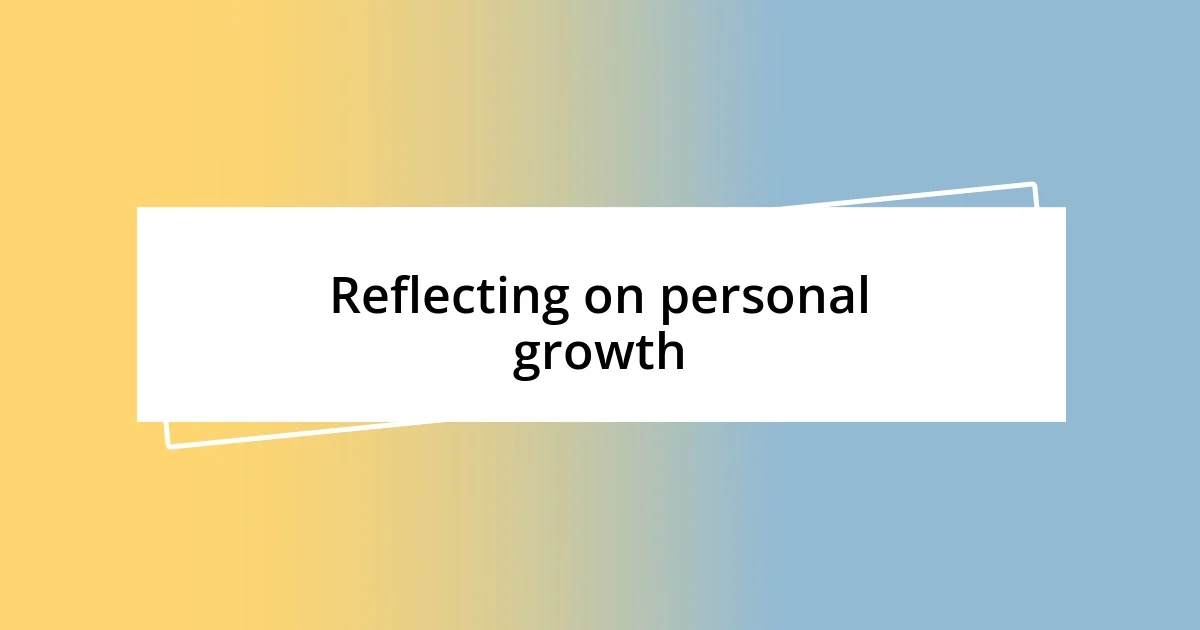
Reflecting on personal growth
Reflecting on my personal growth in activism has been a journey of understanding my values and strengths. I vividly recall a time when I participated in a workshop focused on climate justice. At first, I felt hesitant and unsure, overwhelmed by the complexities of the topics discussed. As the day progressed, I found my voice during the breakout sessions, sharing my experiences and learning from others. That moment taught me that my perspective was not only valid but vital in the conversation. Have you ever experienced a shift in confidence when surrounded by like-minded individuals? It’s those moments that remind us of our collective power.
Over the years, I’ve increasingly recognized the importance of vulnerability in my activism. While preparing for a community forum, I shared some of my fears about the ecological crises we face. To my surprise, many others echoed those same sentiments. This openness sparked a deeper dialogue, allowing us to brainstorm solutions together. It’s powerful to realize that sharing our fears can foster connection and collaboration. Have you seen how vulnerability can lead to collective strength in your experiences?
Lastly, I’ve learned to embrace the process of continual learning. Each activism experience adds layers to my understanding of the issues. Remember that community event where we learned about sustainable gardening? I was a little skeptical at first, wondering how digging in the dirt related to broader environmental problems. But as we shared tips and exchanged experiences, I felt a deeper connection to the earth and our role in nurturing it. I’ve discovered that being open to learning from others not only expands my knowledge but also enriches my activism journey. What steps are you taking to ensure you grow alongside your commitments?












